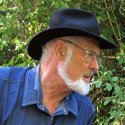Learning Journeys and Episodes. The researcher-learner-traveller within the landscape – package and bespoke learning pathways.
Freed from constraints of trying to squeeze learning into the 4-16, pre-packaged schooling progression the learner has the opportunity to travel along a rich variety of learning journeys and episodes (Roland Meighan, 2005) from the available landscape.
Meighan made some simple illustrations of journeys and episodes contrasting them to the limitations of restrictive schooling.
The current profile of an individual’s learning journey in the UK, for the first stages of their lives looks like this:
One to four/five years: Home–based learning with playgroups experience, and/or child-minding and nursery experience in some cases.
At four/five years: Attendance at a state school with a government dictated curriculum, testing, and inspection with a teacher-directed learning regime, apart from small minorities who attend private schools, or are home-educated by family choice.
At six years: The same
At seven years: The same
At eight years: The same
At nine years: The same
At ten years: The same
At eleven years: The same
At twelve years: The same
At thirteen years: The same
At fourteen years: The same
At fifteen years: The same
At sixteen years: Some continue with the same, some leave school and go into employment.
At seventeen years: The same
At eighteen years: Approaching half the population go to a university where they study a lecturer-directed learning regime with university dictated course contents and testing. A growing minority are choosing the more learner-friendly regime of the Open University at a fraction of the debt incurred from the old-style, ‘late-adolescent three-year exile’, university course.
Within this time period, some will have had some true educational experiences: ‘Some true educational experiences are bound to occur in schools. They occur, however, despite and not because of school.’ (Everett Reimer). But, overall, none of this has much to do with personalised learning. It is people processing. It has been said that education is ‘asking questions all the time’. The profile above is based on the idea of NOT asking questions but learning the required material, and developing only the required skills, hence the description by Paul Goodman of it as ‘compulsory mis-education’.
From the point of view of personalised education, what are the possible building blocks of a learner-managed education? I will call these ‘episodes’ and work in one year building blocks. But such episodes could be shorter – a half year or a quarter of a year. These building blocks can be seen as the macro-level of the catalogue curriculum, the alternative to an imposed, dictated curriculum. The micro-level contains the more detailed items of the content of experiences, projects, courses and, where appropriate, subjects – the whole range of all possible learning experiences available in society, including the methods of invited teaching, research, books, computers, workshops, and so on.
Here is a list of possible ‘episodes’:
- Home-based education – properly acknowledged and supported
- Home-based education learning co-operatives
- Weekday programmes at Community Learning Centres (schools recycled into non-ageist centres)
- Weekend programmes at local Community Learning Centres
- Travel and Study year UK
- Travel and Study year Europe
- Travel and Study year elsewhere
- Residential College (recycled residential school similar to the Danish Efterskole) year with a sports focus
- Residential College year with arts focus
- Residential College year with a music and dance focus
- Residential College year with a rural studies and environmental focus
- Year for exploration of the learner’s locality and its learning sites
- Joining a Democratic Learning Co-operative based on the local Community Learning Centre or public library
- Joining a City as School scheme
- Duke of Edinburgh’s Award Scheme year or a Scouts, Guides or Woodcraft Folk year
- Voluntary work in the community
- Joining an ICT Virtual Learning community or programme such as NotSchool.Net
Readers could add further options to this list.
One individual learning profile might look like this – decided by the learner in conjunction with the family and a support and advice service of a new profession of personal tutor-guides. These would be pedagogues or PEDAs for short, who would act more frequently as educational travel agents than as instructors:
Years one to five: Home–based learning with play-groups experience, and/or child-minding and nursery experience in some cases
Year six: Further home-based education and involvement in a home-based education learning co-operative
Year seven: Weekend programmes at local Community Learning Centres with further home-based learning
Year eight: Weekday programmes at local Community Learning Centres
Year nine: Year for exploration of the learner’s locality and its learning sites
Year ten: Residential College year with a rural studies and environmental focus
Year eleven: Weekday programmes at local Community Learning Centres
Year twelve: Weekday programmes at local Community Learning Centres
Year thirteen: Residential College year with a music and dance focus
Year fourteen: Joining a Democratic Learning Co-operative based on the local Community Learning Centres or public library
Year fifteen: Joining an ICT virtual learning community scheme e.g.NotSchool.Net
Year sixteen: City as School scheme combined with voluntary work in the community
Year seventeen: Residential College year with a sports focus with some music and dance
Year eighteen: Travel and study year UK
Year nineteen: Open University studies along with a Travel and Study year Europe
At the outset of such an ‘episodes’ scheme, many families may ask for the familiar pattern of weekday provision for many of the years. This would be available, on request, in a flexible learning system, with the pattern decided by the learners and their families in conjunction with their personal tutor(s). But, if the experiences of the all-year-round education schemes in USA are anything to go by, the delight of the first families to vary their pattern is catching.
In reality this is only the beginning. The types of setting available are extensive and episodes could be as long or short as desired. Choices could be bespoke and co-constructed or off the peg and packaged from the wider catalogue curriculum offers. Without the current time frames progress can be as diverse, rapid or slow as the learner chooses. Importantly, it can be right for each learner permitting learning to fit with other aspects of his (or her) life. It permits time to strengthen both the wider development of the individual and develop family and community ties and cohesion. Some home-based learners already adopt versions of this approach and they are well attuned to this kind of adaptability. We occasionally hear of the really adventurous… families who will decide to learn together in a totally bespoke fashion perhaps whilst sailing or motorhoming round the world. Others will take on more conventional packages and learning journeys. The important element is that the choice lies with the learner and that the whole spectrum is available for people to mix and match as best meets their needs and circumstances.
The emergent edversity within the educational landscape described by Meighan is conspicuous for its lack of schools. Indeed, schools as we know them cannot live up to the principles and values of personalisation. We cannot avoid the conclusion that they stand in the way of personalised and imaginative responses to learning and living. They are obsolete.
The world our kids are going to live in is changing four times faster than our schools. Dr Williard Daggert.
The reality is that all schools as we know them would be recycled into all age invitational community learning centres. They wouldn’t have one fixed model although they might have a core of quality community resources.
Community Learning Centres.
Schools should be recycled predominantly into all-age invitational Community Learning Centres – a core part of the personalised educational landscape available to self-managed learners.
We might imagine a little further as to what this new personalised educational landscape could mean for people by 2025:
All schools have now evolved into all-age Community Learning Centres (CLC) open 24/7 and all the year round. They all now have the most outstanding world-class facilities for learning, sport and leisure housed in buildings of inspirational design and functionality. Typically, they are built around a comprehensive multi-media library, ICT hub and resource centre. Here much of the community media and publishing facilities are based. Cultural, sporting, health and social service components exist according to local needs. The networks, clusters and federations of schools of the previous decades developed into the CLC networks and collaboratively ensure that learning and setting needs of their communities can be met. The networks are bases for the pedagogues (PEDAs) (Meighan 2005) and extended educational professionals. Master educators steeped in the knowledge and skills of how we learn, how we can accelerate learning, and in human development. They have expertise in assisting those who have challenges in their learning. They act across a range of roles: guide, mentor, coach, tutor, teacher and assessor. They assist in co-producing personal learning plans and help in solution building. They bring together learners with learning experiences and courses. They put learners in touch with key professionals in CLCs. with community based tutors and volunteers, with work experiences and apprenticeships. They are important guides and links beyond the local community. They help co-create learning journeys, inspire and challenge.
Learning takes place in a range of settings in the landscape according to the needs, aspirations and aptitudes of the learner. CLCs still run curricular courses but rarely in groups of more than 10. This facilitates the high quality and quantity of discourse we expect in most learning. The CLCs operate on various cycles so that not all learners and staff and others are in at the same time. There are no traditional schooldays, weekends and holidays.
Distance learning is widely available with external expertise being channelled in via digital links and local follow up. Most learners have flexible learning paths with episodes made up of localised CLC experiences, independent study, distance learning and small group tutoring. Some are home educated and others have periods of home learning. The range of options described by Meighan above are a but a fraction of the available opportunities and all learners have access to high quality resources and support wherever they learn. They follow a mixture of their own naturally defined curricula and they select and modify the catalogue of curricula found locally and globally.
Issue-based integrated curricula and research are at the heart of most learning rather than the isolation of past subject curricula. Experiences are open to all regardless of age. Learners and mentors are well used to supporting, and teaching across the age ranges. What impresses visitors to our communities is the early age at which the learners attain independence. They also come expecting to see choice equalling a laissez-faire, shallow approach to education. Nothing could be further from reality. They find highly committed learners, learning more and more effectively than they did under mass-schooling. The learners are freed from enforced timescales, lessons, terms and years. Readiness is pivotal.
Learning is contextualised in communities where learning is valued highly and where everyone shares the sense of responsibility. Learners are learning because they want to for the benefit of their futures and at their pace and are not jumping through hurdles at the behest of others. Learning is available anytime and independent of place. All citizens have access to the latest ICT, worldwide web and digital connections at home. The country long considered this digital future investment as a necessity in a modern educational landscape. It is recognised as a freely available utility, as also is its transport system.
Some of this kind of thinking already permeates educational futures debates and it is certainly not new. The proposed Minnesota Experimental City (MXC) planned as a laboratory for social, technical and environmental innovation along with a new approach to education looked to replace schools as we know them (Glines 1989). Schools were to be changed into a variety of learning centres:
Early life studios will be designed so that parents, young children and staff members can meet regularly to create an environment that provides creative learning experiences and offers opportunities for parents and older young people and other adults to learn about the mental, emotional, physical and other needs of early childhood.
Stimulus studios will be established, where there will be a constantly changing array of prompts to provoke and extend learners’ perceptions and thinking, to arouse curiosity, to stimulate laughter and, wonder, reverence, imagination and competence. There will be films, tapes, videos, exhibitions, books, resourceful people from the community and virtual reality experiences.
Gaming studios where learning takes place by playing educational games, where there is the opportunity to take part in simulations and role-play, and where arena theatre events will be developed.
Project studios will be available where learners work on real projects, such as making a video, writing a book or TV script, designing new materials and products, or planning projects to be undertaken later in the community. In the UK, Walsall Community Arts has produced a Dreaming for Real project pack which has been setting such projects in motion.
Learner banks will be designed to store and loan out the tools and equipment needed by learners. A large part of the bank would store books and other material now found in conventional libraries.
Family life Centres where families will learn together. The centre will offer meetings, seminars, tutoring or community-centred discussions. For those who learn well some of the time in school-type settings, these will be provided here.
Community facilities such as homes, businesses, public places and sports facilities, will be available as appropriate, as part of the learning network. The network of learning centres will remain permanently fluid open to evaluation, review and change. (From Meighan and Harber 2007)
John Adcock detailed a vision with many features in common with the Minnesota Experimental City Model in his two books In Place of Schools (1995) and Teaching Tomorrow (2000). Even a global corporation like Arthur Andersen Consulting conceived of multi-age Community Learning Centres in every neighbourhood for self-directed learners with facilitators and not teachers (Arthur Andersen and Creative Learning Systems 1999).
The essential point here is that CLCs develop to meet the community need and are established on personalisation principles. Core assets, resources and functions might exist but there might also be differences or specialisms within neighbouring CLCs serving a particular community. Child-care functions would be an important feature to permit the kind of variety in journeys and episodes to take place.
CLCs would be at the core of social policy and be subject to massive funding, continuous development, adaptation and redevelopment as needs change.
Question (from the editors of Education News, New York City): ‘If America’s schools were to take one giant step forward this year toward a better tomorrow, what should it be?’
Answer: ‘It would be to let every child be the planner, director and assessor of his (her) own education, to allow and encourage him, with the inspiration and guidance of more experienced and expert people, and as much help as he asked for, to decide what he is to learn, when he is to learn it, and how he is to learn it, and how well he is learning it. It would be to make our schools, instead of what they are, which is jails for children, into a resource for free and independent learning which everyone in the community, of whatever age, could use as much or as little as he wanted.’ John Holt
Advisors and facilitators were self-selected by the learners. Students could ‘vacation’ whenever they wanted, or ‘learn’ at school, at home, in the community, or in the world… Don Glines (2006) talking about an enlightened programme at the Wilson Campus School, Minnesota



